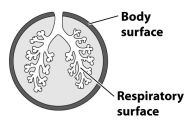Correct Answer

verified
Correct Answer
verified
Multiple Choice
Blood in a capillary leaving a nearby cell would contain
A) a lower concentration of carbon dioxide than when it arrived.
B) a higher concentration of carbon dioxide than when it arrived.
C) a higher concentration of oxygen than when it arrived.
D) less hemoglobin than when it arrived.
Correct Answer

verified
Correct Answer
verified
Multiple Choice
Which of the following describes the journey of a molecule of oxygen from the pharynx to an alveolus?
A) pharynx to trachea to bronchus to bronchiole to alveolus
B) pharynx to trachea to bronchiole to bronchus to alveolus
C) pharynx to bronchiole to bronchus to trachea to alveolus
D) pharynx to bronchus to bronchiole to trachea to alveolus
Correct Answer

verified
Correct Answer
verified
Multiple Choice
Which of the following best describes the journey of an oxygen molecule in a lung?
A) It travels from an alveolus to a bronchiole to a capillary to a red blood cell to hemoglobin.
B) It travels from a bronchiole to an alveolus to a capillary to hemoglobin to a red blood cell.
C) It travels from a bronchiole to an alveolus to a capillary to a red blood cell to hemoglobin.
D) It travels from a bronchiole to an alveolus to a red blood cell to a capillary to hemoglobin.
Correct Answer

verified
Correct Answer
verified
Multiple Choice
The figure below illustrates the respiratory surface of an animal relative to its body surface.  Would you expect this respiratory surface to be found in an aquatic or terrestrial animal?
Would you expect this respiratory surface to be found in an aquatic or terrestrial animal?
A) Aquatic; having the respiratory surfaces inside the body saves energy since water is less dense than air and can therefore be more easily moved through an internal respiratory organ.
B) Aquatic; having an external respiratory surface allows the animal to create a larger surface area for gas exchange.
C) Terrestrial; by having the respiratory surface inside the body, terrestrial animals reduce water loss.
D) Terrestrial; having the respiratory surfaces inside the body prevents gases other than oxygen from entering the body.
Correct Answer

verified
Correct Answer
verified
True/False
Gills were the first gas exchange organ to evolve in animals.
Correct Answer

verified
Correct Answer
verified
Short Answer
The _______ that aquatic animals use for gas exchange have evolved several times, but they are always structured to provide the maximum surface area for gas exchange.
Correct Answer

verified
Correct Answer
verified
Short Answer
Hemoglobin, like many other oxygen-binding pigments, contains the metallic element ____.
Correct Answer

verified
Correct Answer
verified
True/False
The smaller the distance over which a gas must diffuse, the more slowly it will diffuse.
Correct Answer

verified
Correct Answer
verified
Multiple Choice
Hemoglobin
A) is an enzyme involved in the process of cellular respiration.
B) transports oxygen from cells undergoing cellular respiration to red blood cells.
C) binds to oxygen and releases it near cells performing cellular respiration.
D) makes the blood more acidic, enabling it to absorb more oxygen.
Correct Answer

verified
Correct Answer
verified
Short Answer
The _______ of insects are tubes that allow oxygen in the atmosphere to reach the gas exchange surfaces inside the insects.
Correct Answer

verified
Correct Answer
verified
Multiple Choice
Once oxygen has entered the blood stream, its ultimate destination is the
A) alveoli.
B) lungs.
C) cells.
D) mitochondria.
Correct Answer

verified
Correct Answer
verified
Multiple Choice
When we inhale, air moves in through the mouth or nose and next moves into the
A) bronchi.
B) alveoli.
C) lungs.
D) pharynx.
Correct Answer

verified
Correct Answer
verified
Multiple Choice
Which of the following statements about gas concentrations in air and water is true?
A) Carbon dioxide is not found in water.
B) Carbon dioxide occurs in similar concentrations in air and water.
C) Oxygen occurs in similar concentrations in air and water.
D) Oxygen occurs in higher concentrations in air than in water.
Correct Answer

verified
Correct Answer
verified
Multiple Choice
People with sickle-cell anemia have deformed hemoglobin molecules and often suffer muscle pains, even at low levels of exertion. These symptoms might come about because the deformed hemoglobin
A) is unable to carry the oxygen required for normal activities of muscles.
B) cannot diffuse across the cells' membranes from the blood plasma.
C) causes damage to the muscle cells as it enters the muscle.
D) decreases the person's surface area-to-volume ratio.
Correct Answer

verified
Correct Answer
verified
Multiple Choice
Which of the following would contain the lowest concentration of oxygen?
A) a lake covered by a sheet of ice
B) air at sea level
C) air 1,000 ft. above sea level
D) a warm pond
Correct Answer

verified
Correct Answer
verified
Multiple Choice
Which of the following is not a genetic adaptation that has evolved in people who live at high altitudes?
A) large lungs
B) rapid breathing
C) higher hemoglobin concentration in their blood
D) ability of the hemoglobin in their blood to pick up oxygen more readily from the plasma
Correct Answer

verified
Correct Answer
verified
Multiple Choice
The tiniest bronchiole extensions open into the
A) trachea.
B) bronchi.
C) alveoli.
D) pharynx.
Correct Answer

verified
Correct Answer
verified
Multiple Choice
Which of the following would not be a characteristic of an organ used for gas exchange?
A) high surface area
B) covered by waterproofing layers
C) moist surfaces
D) very thin tissues
Correct Answer

verified
Correct Answer
verified
True/False
Ectothermic animals have a larger surface area available for gas exchange than endothermic animals.
Correct Answer

verified
Correct Answer
verified
Showing 41 - 60 of 68
Related Exams